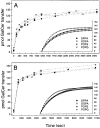Charged membrane surfaces impede the protein-mediated transfer of glycosphingolipids between phospholipid bilayers
- PMID: 10653652
- PMCID: PMC2637181
- DOI: 10.1021/bi991810u
Charged membrane surfaces impede the protein-mediated transfer of glycosphingolipids between phospholipid bilayers
Abstract
A lipid transfer protein that facilitates the transfer of glycolipids between donor and acceptor membranes has been investigated using a fluorescence resonance energy transfer assay. The glycolipid transfer protein (23-24 kDa, pI 9.0) catalyzes the high specificity transfer of lipids that have sugars beta-linked to either a ceramide or a diacylglycerol backbone, such as simple glycolipids and gangliosides, but not the transfer of phospholipids, cholesterol, or cholesterol esters. In this study, we examined the effect of different charged lipids on the rate of transfer of anthrylvinyl-labeled galactosylceramide (1 mol %) from a donor to acceptor vesicle population at neutral pH. Compared to neutral donor vesicle membranes, introduction of negatively charged lipid at 5 or 10 mol % into the donor vesicles significantly decreased the transfer rate. Introduction of the same amount of negative charge into the acceptor vesicle membrane did not impede the transfer rate as effectively. Also, positive charge in the donor vesicle membrane was not as effective at slowing the transfer rate as was negative charge in the donor vesicle. Increasing the ionic strength of the buffer with NaCl significantly reversed the charge effects. At neutral pH, the transfer protein (pI congruent with 9.0) is expected to be positively charged, which may promote association with the negatively charged donor membrane. Based on these and other experiments, we conclude that the transfer process follows first-order kinetics and that the off-rate of the transfer protein from the donor vesicle surface is the rate-limiting step in the transfer process.
Figures









Similar articles
-
Protein mediated glycolipid transfer is inhibited FROM sphingomyelin membranes but enhanced TO sphingomyelin containing raft like membranes.Biochim Biophys Acta. 2005 May 20;1669(2):87-94. doi: 10.1016/j.bbamem.2004.12.014. Epub 2005 Jan 27. Biochim Biophys Acta. 2005. PMID: 15893510
-
Glycolipid transfer protein mediated transfer of glycosphingolipids between membranes: a model for action based on kinetic and thermodynamic analyses.Biochemistry. 2004 Nov 2;43(43):13805-15. doi: 10.1021/bi0492197. Biochemistry. 2004. PMID: 15504043 Free PMC article.
-
General kinetic model for protein-mediated phospholipid transfer between membranes.Arch Biochem Biophys. 1988 Nov 1;266(2):299-312. doi: 10.1016/0003-9861(88)90262-7. Arch Biochem Biophys. 1988. PMID: 3190230
-
Counterion-mediated pattern formation in membranes containing anionic lipids.Adv Colloid Interface Sci. 2014 Jun;208:177-88. doi: 10.1016/j.cis.2014.01.016. Epub 2014 Jan 30. Adv Colloid Interface Sci. 2014. PMID: 24556233 Free PMC article. Review.
-
Organization of glycosphingolipids in bilayers and plasma membranes of mammalian cells.Annu Rev Biophys Biophys Chem. 1985;14:361-86. doi: 10.1146/annurev.bb.14.060185.002045. Annu Rev Biophys Biophys Chem. 1985. PMID: 2988578 Review.
Cited by
-
Sphingolipid transfer proteins defined by the GLTP-fold.Q Rev Biophys. 2015 Aug;48(3):281-322. doi: 10.1017/S003358351400016X. Epub 2015 Mar 23. Q Rev Biophys. 2015. PMID: 25797198 Free PMC article.
-
An electrostatic switching mechanism to control the lipid transfer activity of Osh6p.Nat Commun. 2019 Sep 2;10(1):3926. doi: 10.1038/s41467-019-11780-y. Nat Commun. 2019. PMID: 31477717 Free PMC article.
-
Glycosphingolipids are required for sorting melanosomal proteins in the Golgi complex.J Cell Biol. 2001 Oct 29;155(3):369-80. doi: 10.1083/jcb.200106104. Epub 2001 Oct 22. J Cell Biol. 2001. PMID: 11673476 Free PMC article.
-
GLTP-fold interaction with planar phosphatidylcholine surfaces is synergistically stimulated by phosphatidic acid and phosphatidylethanolamine.J Lipid Res. 2013 Apr;54(4):1103-13. doi: 10.1194/jlr.M034744. Epub 2013 Jan 31. J Lipid Res. 2013. PMID: 23369752 Free PMC article.
-
Cloning and expression of glycolipid transfer protein from bovine and porcine brain.J Biol Chem. 2000 Feb 18;275(7):5104-10. doi: 10.1074/jbc.275.7.5104. J Biol Chem. 2000. PMID: 10671554 Free PMC article.
References
-
- Maggio B. Prog. Biophys. Mol. Biol. 1994;62:55–117. - PubMed
-
- Merrill AH, Schmelz EM, Dillehay DL, Spiegel S, Shayman JA, Schroeder JJ, Riley RT, Voss KA, Wang E. Toxicol. Appl. Pharmacol. 1997;142:208–225. - PubMed
-
- McAlarney T, Apostolski S, Lederman S, Latov N. J. Neurosci. Res. 1994;37:453–460. - PubMed
-
- Radin NS, Inokuchi J. Biochem. Pharmacol. 1988;37:2879–2886. - PubMed
-
- Anderson RGW. Annu. Rev. Biochem. 1998;67:199–225. - PubMed
Publication types
MeSH terms
Substances
Grants and funding
LinkOut - more resources
Full Text Sources
Other Literature Sources
Molecular Biology Databases
Research Materials
Miscellaneous

